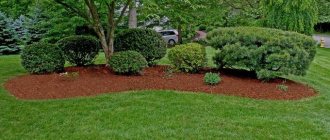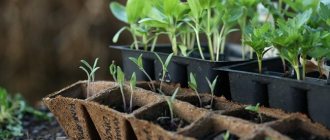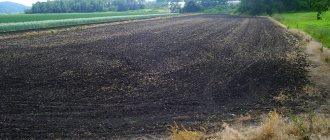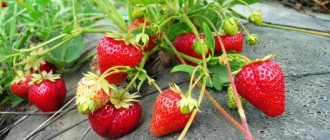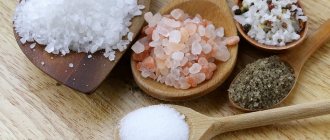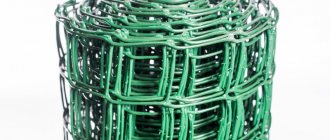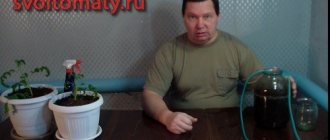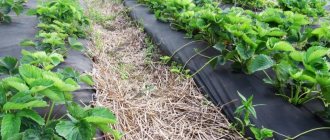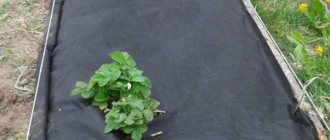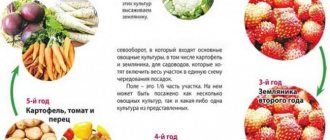Mulching strawberries is one of the reliable ways to protect your crop from diseases and harmful insects.
In order to harvest a large harvest of berries every year, strawberry plantings must be carefully looked after. Weeding and watering are not enough; it is necessary to apply fertilizers, trim bushes and mulch the soil. It is mulch for strawberries that greatly facilitates the work of gardeners, as it helps maintain soil moisture and replenish the nutritional value of the top layer.
Knowledge and technology in laying mulch will help you increase productivity. In this article you will become familiar with what mulch is, how mulching is carried out with different materials, their distinctive properties, the pros and cons of mulching.
Mulch for strawberries: why you need to mulch the soil
mulch for strawberries
mulch for strawberries
This agricultural technique allows you to maintain the necessary soil moisture. And also replenish the nutritional value of the upper nutrient layer, which is most susceptible to weather factors: rain, wind, winter frosts. All this depletes the soil and without your help it will be difficult for it to recover.
Mulch for strawberries has a positive effect on the development of earthworms and beneficial microorganisms that participate in the formation of a fertile soil layer. Mulch for strawberries also plays an important role in protecting the plantation from weeds.
The soil, covered with the fruiting layer of the selected material, does not receive sunlight. Consequently, weed growth first slows down and then stops altogether.
In winter, the presence of a thick layer of mulch is especially important - this will protect the root system of plants from freezing. Strawberries tolerate winter well if they are well covered with snow. But in snowless winters, only strawberry mulch can protect your plantings.
Mulch for strawberries can protect plant roots from the penetration of viruses and fungal diseases, as well as from pests, for example, from slugs and snails, which are always eager to eat berries, but will not be able to move on straw or sawdust.
The mulching method is used for any type of planting of strawberries, except for continuous planting. When the berries are planted in a continuous carpet and it is not possible to sprinkle the ground with mulch.
There are two types of mulch:
- organic
- inorganic
Inorganic - material of inorganic nature is used: PVC film, agrofibre, spunbond, crushed stone, pebbles, expanded clay, etc.
Organic – organic matter is used: peat, humus, straw, sawdust, pine needles, leaves, grass clippings, tree bark, compost, etc.
Gardeners can use one of the types or two types together, for example, black film and straw. The film is used as the main material; it warms the ground in the spring, but straw is laid on top to reflect the sun's rays to avoid overheating of the soil.
If you choose organic material, it will decompose over the course of the season, feeding the soil. Well, one more important advantage of mulching is that even the heaviest and largest berries do not touch the ground, do not rot or get dirty.
The best type of mulch for strawberries may be different for everyone. Depending on the type of soil on your site, on the variety of berries you chose for planting and others, on environmental conditions and other factors.
Features of watering strawberries with mulch
When watering a garden strawberry plantation that is covered with mulch, you must follow some rules. To avoid waterlogging of the soil and the occurrence of fungal infections, it is better to water in the morning so that the mulch dries out during the day.
When covering with film, watering is done at the root. To save water, you can organize drip irrigation under the material. Before watering, it is necessary to check the soil: if it is wet and loose, then it is better to postpone watering.
Watering strawberries.
When using cardboard, it is recommended to water under each bush so that the shelter does not get wet and is preserved throughout the summer.
How to mulch strawberries in spring, summer and autumn?
Remember, the soil needs to warm up in the spring, so it is not recommended to keep strawberries under mulch all year. Mulching of strawberries begins with the appearance of the first flowers.
Mulching strawberries can also be transferred to the summer. But before that, you must prepare the soil and the strawberries themselves:
– loosen the soil – cut off tendrils and wilted leaves – water well – feed.
If you laid mulch in the summer, be sure to monitor its condition. Organic materials must be stirred up, and areas where there are putrefactive masses must be removed. Do not allow the mulch to completely adhere to the bushes of the plant; leave a gap of 2-3 cm so as not to disturb the air exchange.
In autumn, mulching takes place in September, when the strawberries have given their last harvest and are at rest. Then the mulch will serve as protection against freezing of the soil and prevent damage to the roots.
But before you choose any one material, think about why exactly you want to mulch strawberries? Do you need protection from weeds, diseases and harmful insects, or do you want to fertilize the soil and feed the plants? Depending on your purpose, choose one of the materials suggested below.
Recommended timing of work
It is better if the strawberries are constantly under mulch. But in the spring the soil needs to warm up well, otherwise the natural vegetation cycle may be delayed. Plants are mulched in the spring before flowering, after the buds appear, but the procedure can also be carried out in the summer.
Regardless of the method used, the soil must be properly prepared:
- loosen to restore air exchange;
- remove damaged leaves from bushes, cut off mustaches;
- weed the beds, completely remove weeds;
- water;
- apply the necessary fertilizer.
Before winter, mulch is applied after the garden strawberries are fully prepared for the dormant period. Do not ignore this need, because the device will act as a thermostat and will help prevent the roots from freezing in the event of a cold and snowless winter.
It is not enough to arrange mulch; you need to control its condition, especially if an organic cover is used. It must be tossed, inspected for rot, and ensure that it does not touch the stem of the plant.
If you ignore this point, you may miss the spread of diseases and lose plantings. The gap between the mulch and the stem should be at least 1 cm, this is necessary for normal air access to the root system.
Mulching strawberries - what to use?
Below we will analyze what types of mulch are, analyze their qualities and disadvantages, and understand the purposes for which each type of mulching serves.
Straw
It is in first place among those materials that are suitable for strawberries. For mulching, you need to take dry material. Straw has a high fiber content, thanks to which it protects the straw from rotting. And the same reason is a poor power source. In addition, straw draws minerals from the soil. To prevent loss of minerals, straw is mixed with manure. A layer of straw is laid out depending on the soil.
When the soil is loose - 12-17 cm of straw will be optimal for mulch; after two or three days the mulch will settle by 8-10 cm. If the soil is heavy and has a clay layer, then mulching strawberries with straw is carried out in a small layer of 5-7 cm, changing the mulch every two weeks.
It's no secret that straw is an excellent refuge for mice. Therefore, in September, the straw mulch must be removed.
Advantages:
- natural, organic material;
- easily accessible;
- allows water to pass through;
- breathes;
- during decomposition, it enriches the soil with nutrients;
- reflects the sun's rays;
- absorbs evaporation from the soil.
Flaws:
- often sold in compressed bales that are very difficult to break;
- long stems are difficult to lay, you have to trim them, and this takes a lot of time and effort;
- it is difficult to lay firmly, as a result weeds are able to break through it;
- when decomposed, it acidifies the soil, so cannot be used on acidic soils;
- may contain weed seeds.
Needles
Needles – contains a high amount of phytoncides. These substances are powerful weapons in the fight against parasites. Also, thanks to pine mulch, your strawberries will be sweeter.
Over time, needles acidify the soil due to their tannins. Therefore, it is well suited for slightly acidic soils. But there is another option: before laying the pine mulch, add slaked lime at a rate of 50 grams per square meter.
Yellowed pine needles - pine litter - are used for mulch. Coniferous litter is laid in a small layer of up to 5 cm. In spring, the mulch must be renewed, but the old one does not need to be removed; during hilling the bushes, it will mix with the ground.
It should be taken into account that pine needles provide practically no protection from the sun, so such mulch is not particularly suitable for hot regions.
Advantages:
- delays moisture evaporation;
- allows air and water to pass through;
- disinfects the soil;
- protects against gray rot;
- protects berries from slugs and snails, they do not like to crawl on it.
Flaws:
- it is difficult to collect in sufficient quantities in the forest;
- difficult to place, itchy;
- contains, in addition to needles, branches, scales of cones;
- acidifies the soil;
- due to its looseness, it does not inhibit the growth of weeds well.
Therefore, when approaching the question of whether it is possible to mulch strawberries with pine needles, proceed from the possibilities of collecting pine needles and the region of your residence.
Hay, fresh grass
Fresh grass is enriched with fiber, which decomposes quickly. The berry will be provided with nutrition, but not for a long period. Since due to the rapid decomposition of fiber, the mulch layer will quickly deplete, this will cause the lower layer to rot. Thus, the berries will be poisoned by putrefactive products that will enter the root system.
Hay - in order for the hay mulch not to serve only as a temporary fertilizer for the plant, the hay should be laid out in a layer of 8-12 cm and after two weeks it should be replaced with fresh mulch. This is a very labor-intensive process. Before laying out the hay, you need to dry it well.
Mulching strawberries with grass clippings has its advantages and disadvantages.
Advantages:
- retains moisture;
- increases the fertile layer of soil when rotting;
- inhibits weed growth;
- folds out conveniently.
Flaws:
- when it dries, it decreases in volume, so it needs to be added constantly;
- You need to spread it out gradually; if you spread it out in a thick layer at once, the grass will rot.
Pine bark
Good as mulch. The content of tannins in pine is low, which means that the soil will not oxidize. This material is long-term and can last 5-6 years. But you will have to water the beds often; bark mulch does not retain moisture well. It is laid out in a layer of 4-6 cm. This mulch can be left for the winter. It will prevent the soil from freezing and will preserve the roots of your plants.
Advantages:
- protects the soil from the growth of weeds;
- retains moisture;
- protects the soil from weathering;
- protects the berries from contact with the soil;
- looks good.
Flaws:
- the soil dries out faster compared to other types of mulch;
- acidifies the soil;
- difficult to remove.
Sawdust
They are not a source of nutrition as they decompose slowly. Their service life is quite long, up to 4 years. Sawdust retains water for a long time, so there will be no need for frequent watering. To mulch with sawdust, you need to cover the soil with newspaper, and then lay out a 4-6 cm layer of sawdust. Thanks to this mulch, there will be fewer slugs in your garden bed, due to the rough surface of the sawdust. Sawdust mulch can also be used before winter.
Advantages:
- retain moisture
- reflect the sun's rays;
- lay down in an even layer;
- perfectly inhibits the growth of weeds;
- protects against slugs and snails;
- help improve soil structure;
- have a decorative effect and look beautiful in garden beds.
Flaws:
- fresh sawdust absorbs nitrogen when decomposing, so you need to use either already rotted sawdust or additionally add this element to the soil;
- acidify the soil, so it is better to apply them together with ash, lime and other substances that reduce soil acidity.
Cardboard
Cardboard – used to optimize the soil environment. To do this, you will need pieces of cardboard, which should be laid on the beds, but not close to the bushes, 4-6 cm away from the strawberries. To prevent the cardboard from moving, it is enough to press down on the edges with a small weight. Water and feed strawberries throughout the season through the hole. It is recommended to pour compost under the cardboard in the summer and then the strawberries will receive nutrients all season long.
Spandbond
Spandbond, a geosynthetic material, has a special technology; it does not allow light to penetrate, maintaining a certain temperature in the soil, creating an optimal moist environment in the soil. Through this material, you can water and feed the berries.
If you don’t know how to mulch strawberries during the fruiting period, then this method will suit you.
For strawberry mulch, black material is used that is quite dense - 80 g/m2. To begin with, spread the spandbond evenly on the future bed, cut holes and plant seedlings in them. If mulching occurs in a bed already with strawberry bushes, then cover it with material between the rows of bushes, without leaving open areas. This mulch will last up to 4 years without requiring replacement.
For mulching, it is better to buy a two-color one. On the one hand, black, on the other, white. The light side will reflect the sun's rays and the soil will not overheat.
Advantages:
- slows down the evaporation of soil moisture, as a result of which the soil remains moist for a long time;
- does not allow sunlight to pass through, which helps avoid burns to the root system;
- inhibits the growth of weeds;
- allows air to pass through;
- smoothes out spring and autumn temperature changes;
- You can use the traditional watering method.
Flaws:
- Condensation may form on the surface of the spunbond, which increases the risk of strawberry disease;
- in hot weather, the soil under this material warms up greatly.
To prevent the soil from warming up too much during the hot season, the spunbond is raised and the soil is ventilated.
Film
Film - for mulch, it is usually taken at least 25 microns thick and black. This mulch will last 2-3 years. If you plan to use it for one season, then you can get by with thinner material. The film is laid in the same way as spunbond, the difference is that in this case the strawberries must be watered through the holes.
If you use different materials for mulching at the same time, then this will only be beneficial for the berries. You can combine bark and grass, compost and manure. Thanks to this mulching, the plants will be provided with a favorable environment.
Advantages:
- retains moisture in the soil;
- helps fight weeds;
- prevents strawberry tendrils from taking root;
- protects berries from contact with soil;
- protects the plant from temperature changes;
- in spring it helps warm the soil by 2 degrees;
- durable.
Flaws:
- black color attracts the sun, so in summer the soil can overheat;
- the film does not allow air to pass through, the same reason for overheating of the soil;
- overheating of the soil can lead to root wilting;
- retains excess moisture, which leads to the appearance of woodlice, slugs and fungal diseases;
- It is necessary to organize drip irrigation under the film, and this is expensive.
Compost. Humus
Advantages:
- improves soil properties;
- increases the fertile layer;
- is an excellent fertilizer;
- protects against weed growth;
Flaws:
- due to its dark color, it increases soil temperature;
- may contain weed seeds, insect larvae, and fungal spores.
Peat
For mulching, it is better to use neutral peat with a low acidity level.
Advantages:
- allows moisture to pass through and slows down its evaporation;
- allows air to reach the roots;
- controls weeds;
- It's a pleasure to work with him.
Flaws:
- when watering, it absorbs moisture, so you need to monitor whether the soil under it has become moist;
- dark color increases soil temperature;
- difficult to get.
Inorganic mulch
Inorganic materials are also used.
Film (agrofibre)
For strawberries, use black plastic film. The following advantages of the process are highlighted:
- the film maintains a constant water level in the soil;
- helps keep berries clean and of high quality;
- facilitates harvesting;
- increases soil temperature by 2°C;
- bushes lined with black agrofibre take root faster.
Mulching the area is carried out before planting strawberries as follows:
- the land is fertilized;
- dig well;
- level and water;
- the surface is covered with film, the ends are secured at the edges;
- then cross-shaped cuts are made in it - at a distance of 30 cm in a row, between rows 40-50 cm;
- Strawberries are planted in the holes.
In order for the film to last longer, its thickness must be at least 30 microns. Its color is also a very important characteristic:
- The black film performs two functions at once - it warms the soil and prevents weeds from germinating. It is suitable for temperate regions where summers are short and changeable.
- For the southern regions, brown, gray or two-color film is used - it is black on top and white on the bottom. These colors save the soil from overheating.
- White or transparent film is not suitable for mulching, as it does not prevent the growth of weeds.
However, agrofibre also has disadvantages:
- watering is carried out only through holes;
- with excessive watering, condensation accumulates under the film, which provokes root rot or the appearance of slugs;
- during frosts in spring, condensation can lead to freezing or death of plants;
- rapid depletion of the soil occurs, there is a lack of oxygen, since the film does not allow the passage of not only water, but also air;
- in hot weather it gets very hot, the root system overheats;
- The shelf life of the material decreases with sudden temperature fluctuations and under the influence of direct sunlight.
Nonwovens
Experienced gardeners are increasingly using non-woven materials for mulching. They are more durable compared to film, but they are also much more expensive, they allow air and moisture to pass through, and watering can be carried out over the entire surface, and not just into the hole.
The following materials are available on the market:
- Russian-made - agrotex and spunbond;
- Ukrainian - agrin;
- German - lutrasil;
- French - agril;
- Polish - plant-protex.
Despite the apparent diversity, they differ from each other only in the weaving and processing of polypropylene threads, but they have the same functions.
The material consists of two layers - the first allows moisture to pass through well, the second retains it. During dry periods this is a big plus. However, during rainy summers, the soil becomes waterlogged. For mulching, it is enough to take non-woven fiber with a density of 60 g/m2. m. The algorithm for using fiber is the same as when using film.
Cardboard
Compared to other inorganic methods, this is the most economical and environmentally friendly method. Over the entire area of the plot, sheets of cardboard are laid overlapping (15-20 cm on each side) and a fertile layer of soil 10 cm thick is poured on top of it. Leave everything for a week and begin planting berry seedlings.
To do this, using a scoop or knife, holes are made in cardboard with a layer of mulch - holes, where the root system of the plant is placed. Sprinkle it with fertile soil, compact it and water it well. Watering is carried out directly into the hole, trying not to get on the cardboard so that it does not get wet quickly and lasts as long as possible. After a season, the cardboard usually overheats, so the procedure is repeated the next year.
Mulching is a fairly simple procedure that any novice gardener can do. Compliance with agricultural technology, correctly selected mulch and the thickness of its layer only brings benefits to strawberries and increases their productivity.
0
0
Copy link
The benefits and harms of mulching
Summer residents still cannot come to a consensus on what is better. Some claim that thanks to mulching, strawberries are harvested well. Others say that mulch has a detrimental effect on plants. Let's consider all the advantages and disadvantages of mulching.
Advantages
Mulching with different types of materials will help solve many problems for a summer resident:
- protects against soil freezing in winter
- prevents soil from overheating in summer
- retains moisture in the soil
- prevents the growth of weeds
- the soil is less susceptible to disease
- the berry is not subject to rotting
- the soil remains loose
- berries ripen faster
There are quite a lot of advantages to resort to mulching strawberries, but if you do all this separately, you will need a large amount of money and quite a lot of effort.
Flaws
- The downside to mulch is that it provides a breeding ground for slugs. Moist soil under mulch becomes a home for snails, and decomposed organic matter becomes good food for insects. But this does not mean that you need to give up mulching. If there is an abundance of these pests in your summer cottage, then it is most advisable to use mulch made from pine needles or sawdust. Such mulching will create a biocenosis that will help not to exclude, but to maintain the number of shellfish without harm to strawberries.
- Another disadvantage may be the rotting of the bottom layer of mulch. This usually occurs due to heavy rainfall and, if the soil being covered with mulch is quite clayey. But here it is enough to know the climate of your region and not to lay mulch in a thick layer on heavy clay soil. And it is necessary to monitor the mulch throughout the season.
- Mulching attracts rodents, birds and many insects. And this is also what summer residents call a disadvantage of mulch, but it is incorrect to consider this a disadvantage. After all, a summer cottage, as a rule, has vegetable gardens and greenhouses where other crops are grown, thereby attracting all sorts of pests.
Experts are confident that people’s misconception about the dangers of mulching is due to the fact that people do not have all the information about the correct use of mulch material in different regions.
It is important to know that mulching will not solve all your problems, but it will help gardeners save budget, effort and time.
Why is mulch necessary?
Why and when to mulch strawberries is a pressing question for novice gardeners. The procedure is necessary for growing a rich harvest of berries, freeing from constant watering, weeding, weed growth, diseases and pests.
Thanks to mulching strawberries, a positive effect is achieved:
- The soil does not dry out or become waterlogged.
- Optimal temperature is maintained.
- The soil is protected from pests and diseases.
- Weeds do not spread.
- Contamination of fruits during rainy weather is prevented.
- Soil characteristics are improved.
- Productivity increases.
Strawberry mulch fulfills almost all the tasks a gardener faces when he decides to plant and grow berries.
Straw
Straw is the most traditional material for mulching strawberries - its use can improve the quality and quantity of the crop.
To achieve the desired effect, the straw must be prepared for the procedure: to do this, it is cleared of weeds by shaking it, and then soaked, followed by drying in the sun. It is also necessary to prepare the site - it is cleared of weeds and the soil is thoroughly loosened. The actual procedure is carried out as follows: straw is laid around the bushes in an even layer up to 7 centimeters thick.
It must be remembered that the first mulch is removed from the ground after harvesting, and then, when necessary, a new layer is laid.
Why mulch?
The benefits of mulching are as follows:
- this “blanket” retains moisture in the soil in the root zone of the plant;
- In winter, mulch protects the roots of the crop from frost;
- it is a kind of soil conditioner that helps create an optimal balance of substances beneficial for strawberries in the soil and significantly improves the soil structure;
- beneficial substances are not washed out or eroded from the soil;
- the growth of weeds, which often causes poor yields, is suppressed;
- organic matter helps beneficial microorganisms develop more intensively in the soil and takes an active part in increasing the efficiency of their work;
- garden pests do not have the opportunity to get close to the rhizome of the plant;
- Thanks to mulch, soil will not be splashed onto the leaves of plants when watering.
What crops can be mulched with sawdust?
Trees, shrubs, and flowers are mulched with sawdust.
This material is used to cover beds with vegetables and berries; for this, the space between the beds is sprinkled with sawdust to reduce the growth of weeds.
For decorative mulching of flowers, trees or shrubs, sawdust of large fractions can be painted in various colors. This adds unique splendor to landscape design.
This type of mulch is used to grow vegetables such as carrots, potatoes, onions, and cucumbers. On carrots, the smell of sawdust prevents the appearance of carrot flies. To increase the potato yield, mulching the distance between plants with sawdust after hilling has a good effect.
In combination with nitrogen fertilizer, this layer ensures better crop growth.
Mulching with sawdust is an inexpensive and effective way to increase crop yields, preserve and increase soil fertility, as well as give the garden an aesthetic appearance.
Author of the article: Kozhukhova Elena
Mulching is an agrotechnical technique
, reducing moisture loss in the soil and improving the structure or composition of the soil.
In addition, mulch protects the plant from:
- overheating and freezing of roots;
- slugs;
- weeds.
Any garden and vegetable plants receive nutrition and substances necessary for growth in the form of aqueous solutions, which they absorb with the help of their roots.
Therefore, the lower the soil moisture, the more difficult it is for the roots to extract nutrients from the ground, so the soil must be constantly moistened.
However, frequent watering often leads to rot, so it is extremely important to increase the interval between waterings and reduce the rate of water loss from the soil
Water leaves the soil in four ways:
- it is consumed by plant roots;
- it seeps into deep layers of soil;
- it evaporates due to heating by the sun's rays;
- she is carried away by the wind.
The influence of the first two points cannot be stopped or slowed down.
Therefore, it remains to influence the evaporation of water
due to heat and wind. Mulch, that is, material covering the ground, reduces the intensity of soil heating and also separates the soil surface from moving air, which is why water losses caused by these factors are reduced.
After rotting, mulch made from natural materials mixes with the soil and improves its structure
, making the soil looser. Thanks to this, plant roots have easier access to water, because in loose soil the moisture is distributed more evenly, so it naturally compensates for what the roots have consumed.
If water in the soil and roots freezes, it will increase in size and rupture the root cells.
, after which they will no longer be able to perform their functions normally. Thanks to the heat-insulating properties of mulch, the water in the roots does not freeze even in severe frosts, and in the spring it is easier for the plant to wake up from sleep and resume growth.
In addition, mulch protects the beds from slugs and weeds, because the former experience discomfort when moving on a very uneven surface, and the latter cannot grow normally through a thick mulch layer.
Preliminary preparation of collected green mass
For mulching, grass is used in the following states of aggregation:
- fresh;
- dry;
- partially rotten.
Fresh
If you plan to use freshly cut grass as mulch, then no preparation is required - it is immediately laid out around the area .
This material contains the maximum amount of nitrogen, so its consumption by humus-forming bacteria compensates for the excess of this material and after mulching the soil does not lose nitrogen.
The disadvantage of this method is the strong toxic effect on cultivated plants, which is stronger the less compatible the plants are.
manure is best suited for fresh mulching , which after ripening is cut or trampled down so that they die and begin to rot.
Partially rotten
To obtain partially rotted material, the collected vegetation is placed in a composter or barrel for the time necessary for the rotting to reach the required level.
By waiting for one or another stage of decay, both the mechanical properties of the mulch and its attractiveness to worms are regulated, this makes it possible to obtain mulch that is better suited to a specific situation than other materials.
The advantage of partially rotted mulch is the high content of transition substances, due to which bacteria produce humates much faster than in fresh grass, and there are still quite a lot of substances attracting worms in such material.
Dry
To dry, the vegetation is collected in stacks and left in a well-ventilated and lit area, then, when the humidity drops to the required level, it is used for mulching.
If it needs to be stored until spring, then the dry green mass is placed in a closed, well-ventilated and insulated room. This material contains less nitrogen, so in spring and autumn the area mulched with it must be fertilized with nitrogen-containing preparations.
In addition, dried vegetation is much less toxic than fresh, so even grass that is usually incompatible with cultivated plants on the site can be used for mulching.
The main advantage of dried grass is that it can be mulched even in early spring, when fresh grass is not yet available. The main thing is not to lay it close to cultivated plants.
At the same time, dry mulch retains the attractiveness characteristic of fresh vegetation for worms, due to which its application to the site leads to an increase in their number, and therefore increases the efficiency of soil regeneration processes .
It is also more effective than fresh grass if it is necessary to protect plant roots from heat or frost. The only downside is that violation of drying and storage conditions can lead to mold or rotting, which will negatively affect the effectiveness of the mulch.
Mulching in autumn
Sawdust can also be added during the period when the berries are ripening. By the end of summer, some of them should be removed. A thick layer of mulch begins to rot due to the arrival of prolonged rains, which often accompany August. This phenomenon has a detrimental effect on the condition of the roots.
Quite often, owners of gardens and summer cottages use sawdust to cover the beds where they grow strawberries for the winter. By mulching the crop in the fall, they combat soil freezing. Natural material hides the roots of the bushes from the cold.
Sawdust from coniferous trees also contains phytoncides, which prevent the development of rot, which is caused by bacteria.
Dense mulch, and it should be laid in a layer of 10 centimeters, will serve as an excellent material for insulation. Engaging in this process throughout the entire period:
- protect plants;
- accelerate their growing season:
- enrich the earth;
- change the structure of the soil.
If snow falls late in the region and melts more than once during the winter, it is worth making a frame before mulching. Plastic slats or thin branches are suitable for this. The strawberry bushes are covered with a polyethylene film, and dry sawdust is placed on it. The constructed hut will perfectly cope with the vagaries prepared by nature.
Strawberries are not a fastidious crop. But if you don't take care of it, it is reborn. The berries become small and lose quality. Mulching for a plant is as necessary as watering, weeding, fertilizing or loosening.
Share your experience of mulching strawberries with sawdust. And also watch a video about mulching strawberries with sawdust in the garden.
Features of mulching with sawdust
There are a lot of organic mulching materials available. Due to the development of agriculture, sawdust is more often used for mulching. Despite its cheapness, the material brings great benefits. Sawdust is used both in winter and summer. They prevent crop roots from freezing. It is enough to lay them out on the beds and compact them. To prevent sawdust from fluttering in the wind, cow manure is added to the mulch.
The soil is mulched for the winter in mid-October or early November. A layer of up to 3 cm is laid on the beds. But mulching with sawdust is not suitable for all plants and types of soil. Be careful with oak and pine sawdust! The thickness of the mulch layer is selected for different crops:
- for tulips, garlic and onions it is 6 cm;
- for strawberries and carrots – up to 4-5 cm.
| Material | Features of application |
| Suitable for bulbs (flowers and vegetables), strawberries, carrots, beets and berry bushes. | |
| Like sawdust, it takes a long time to rot, so it is used for early crops. The layer reaches 10-15 cm. | |
| Suitable for all vegetable crops. | |
| Grass (hay) | It quickly rots and saturates the soil with nutrients. Grass or hay is laid in a layer of 4-6 cm. |
| Fallen leaves | Suitable for cabbage and beans. Also cover flower beds for the winter. |
There are several approaches to mulching the soil. Mulching according to Kuznetsov has its own characteristics:
- The row spaces are covered with a thick layer of sawdust to prevent the growth of weeds.
- Biocompost is added to the beds themselves. If the soil is clayey, then sand is added.
- As the crops grow, sawdust is added between the rows, the beds themselves are loosened and biocompost is regularly added.
- The berry fields are covered with a layer of sawdust and mulch is added regularly.
- Sawdust can be applied on top of the manure, which will retain moisture.
To loosen the soil, improve its structure and speed up the decomposition of organic fertilizers on the ridges, it is worth casting earthworms. Alexander Kuznetsov refutes the opinion that sawdust, like mulch, adds to the soil, because it is applied on top of the soil. It is not sawdust that acidifies the soil, but the mushrooms that destroy it.
What mistakes do gardeners make when mulching berries?
If you don’t know how to mulch strawberries correctly, you may not only fail to succeed in growing them, but also cause harm to the crop being grown. Experts identify the following mistakes when using mulch:
- Constant covering of the ground. It is not recommended to cover the ground continuously: it needs to warm up. Otherwise, the ripening process will be slowed down, so it is important to remove the fertilizer layer in time.
- Excessive moistening of the mulch. If you do not monitor the moisture concentration, slugs and other pests will actively multiply - it is important to remove excess liquid in a timely manner.
- Use of low-quality or unsuitable raw materials. The properties of the material must be suitable for the specific type of soil.
Thus, mulching is useful for growing berries, as well as lawn grass, vegetables and fruits. The best way to mulch strawberries - with agrofibre, sawdust or other materials - depends on the characteristics of the soil. If you lack knowledge about the procedure, you should consult with experienced gardeners.
Features of pruning bushes in autumn: pros and cons
After the end of fruiting, the period of caring for strawberries begins. One important aspect is pruning bushes. Removing all leaves from strawberries in the fall is done in order to redirect all the forces of the bush to the development of the root system. There are both pros and cons to this.
Positive sides
- Pruning leaves helps improve root development. When the entire above-ground part of the bush is removed, all beneficial substances circulate only in the roots and nourish them with a large amount of vitamins and minerals that the plant needs in winter. At the same time, the root thickens significantly;
- Gardeners believe that removing leaves increases the plant's frost resistance;
- Pruning helps renew the bush and remove all pathogens and pests that linger on damaged leaves.
Cons of pruning
- By removing the ground part of the bush, the buds from which the fruits are formed are also removed. This will significantly reduce the amount of harvest;
- Longer development of the bush. After pruning in the spring, the above-ground part takes longer to form and you can’t hope for early fruiting;
- Pests usually overwinter in the soil. Therefore, trimming the leaves will not provide radical protection.
Trimming: step-by-step instructions
- remove the leaves at a height of 10 cm from the ground, leaving the stems and not affecting the growing point. After a short period of time, the leaves will begin to grow again;
- cut off all tendrils and rosettes if you do not plan to propagate the bushes. Thus, the berry harvest will increase;
- remove all weeds from the garden bed, as they pull nutrients from the soil;
- pruned leaves and weeds are raked and burned to prevent the spread of fungal spores.
Pruning should be done in July or August. If it was not possible to complete this type of work during this period, you can prune the bushes no later than the beginning of September. This temporary limitation is explained by the fact that before the onset of the first frost, young foliage must have time to grow on the bushes.
What happens if you don’t do the procedure?
If a gardener does not use mulch on strawberries, it can reduce the yield. The berries will be dirty, small and tasteless. It can also cause the plant to become diseased or be destroyed by pests. Failure to mulch for the winter can cause freezing and death of seedlings.
Check out: strawberry yield per hundred square meters and per hectare.
Mulching makes it possible to grow stronger and more resilient bushes that will produce a good harvest. Harvesting such a crop will be greatly facilitated, due to the fact that the berries will be clean and compactly located on the bush. Using different means to cover the bushes, you can grow an excellent harvest of berries.
Mistake #7: Mulching the plant, not the soil
Plants should not be “wrapped” with mulch, i.e. place it too close to their stems or trunks. Some gardeners like to build entire mounds of bark or other mulching material around trees. This may be beautiful, but it will not add health to the green space; on the contrary, it can lead to rotting of its root system and death.
Such mounds do not allow water and air to pass through well, and pests and pathogens find refuge there. Therefore, you should not get carried away with such structures. The mulch layer must be laid so that it does not touch the plants. Leave some space around them.
Sawdust and strawberries at different times of the year
Spring
In the spring, the old mulch is removed and a new layer is created anew. The substrate made of newspapers or branches should be checked for suitability, and if necessary, also replaced.
Summer
In the summer, you can do nothing with sawdust mulch, but simply monitor its condition. If desired, you can remove the contaminated sawdust and add fresh sawdust so that the strawberry berries are on a clean layer.
Autumn
In the fall, you will have to renew the mulch layer. You can also apply a layer of sawdust directly under the bushes for the winter, this will protect the plant from the cold. But is it worth sprinkling the bush itself with sawdust? The answer here is ambiguous. If winters in your region are “neither fish nor fowl” - that is, there are almost thaws, then frost again - then before using sawdust, you should make something like a frame of branches over the bushes, cover it with film, and only then sprinkle it with sawdust.
And, most importantly, get well-structured soil populated with beneficial microorganisms.
The most common loosening of the bed after watering is mulching, which conserves moisture. However, the soil surface does not remain in this form for long - until the first watering or rain. After this, the earth becomes covered with a crust, and work can begin all over again. In order not to walk around the beds with a hoe in your hands all summer, the soil is covered using various materials. With their use, much less time and effort is spent on care, and the growing conditions for the garden become better.
Treatment against diseases and pests
Before the onset of cold weather, strawberries must be treated with products that protect against diseases and parasites. In autumn, as a result of increased humidity, the risk of fungal diseases and pest attacks increases. To prevent and prevent fungal infections, it is necessary to treat strawberry bushes with preparations containing copper.
Such drugs include:
- Bardos mixture;
- copper oxychloride;
- “Nitrafen” (has universal properties. Destroys fungal spores, insect larvae, disinfects the soil);
- strong solution of potassium permanganate. Water the soil around the bushes.
To control pests, treatment with such drugs as:
- "Karbofos";
- "Aktara";
- "Karate".
Black mulch fabric for strawberries
In different producing countries, this fabric has different names: spunbond, agrin, agril, virotex, texfil, gromax, agrofibre lutrasil. This material regulates the optimal amount of moisture in the soil and effectively slows down the growth of weeds.
Spunbond is good because it can last for more than one year. To use it, you need to prepare the soil: clean it, moisten it, cut holes according to the planting pattern of your strawberry bed. After laying the edges of the spandbond, press the edges with something heavy (for example, stones).

